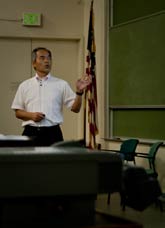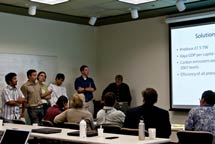
Handy Links
SLAC News Center
SLAC Today
- Subscribe
- Archives: Feb 2006-May 20, 2011
- Archives: May 23, 2011 and later
- Submit Feedback or Story Ideas
- About SLAC Today
SLAC News
Lab News
- Interactions
- Lightsources.org
- ILC NewsLine
- Int'l Science Grid This Week
- Fermilab Today
- Berkeley Lab News
- @brookhaven TODAY
- DOE Pulse
- CERN Courier
- DESY inForm
- US / LHC
SLAC Links
- Emergency
- Safety
- Policy Repository
- Site Entry Form

- Site Maps
- M & O Review
- Computing Status & Calendar
- SLAC Colloquium
- SLACspeak
- SLACspace
- SLAC Logo
- Café Menu
- Flea Market
- Web E-mail
- Marguerite Shuttle
- Discount Commuter Passes
-
Award Reporting Form
- SPIRES
- SciDoc
- Activity Groups
- Library
Stanford
Around the Bay
Energy Summer School Focuses on Solutions
How do you reduce global carbon emissions by 50 to 80 percent in 41 years?
That question was put before participants at the start of the SLAC-Stanford–NREL Energy Summer School two weeks ago. Then, between lectures and activities in the two-week residential program, the science and engineering graduate students worked in groups to figure out how to make it happen. Last Friday, at the Research Office Building's Redwood Conference Room, they made their recommendations.
And as the groups discovered, making even modest reductions in carbon emission is tricky. The proposals varied widely, but all approached the problem holistically, culling from the summer school content to come up with well rounded solutions. The ultimate lesson, though, seemed to be that no part of the problem is too small for consideration—not even something like cement production.
"When you think about what the energy future looks like, you don't usually think about cement production," said participant and University of North Dakota Engineering graduate student David Dvorak. Dvorak's group, named Plan B, tied for first place. "But it's such a big problem, you can't overlook anything."
The presentations and awards provided a wrap-up the two week summer school, which brought more than 50 students and scientists to Stanford and SLAC—one week on each campus—for two weeks of lectures. The Stanford Institute for Materials and Energy Sciences organized the summer school, together with the Precourt Institute for Energy and Global Climate and Energy Project and the National Renewable Energy Laboratory.
"The goal of the summer school was to provide an overview of the energy and environmental challenges facing our society," SIMES Director Zhi-Xun Shen said. "Energy issues are so comprehensive that conventional courses do not cover the kind of scope and depth that a combination of 20 leading experts in a focus workshop can."
The first week of the summer school, held on the Stanford campus, addressed broad energy challenges, with presentations on climate science and issues in energy resources, distribution and utility. The second week, held at SLAC, zoomed in, taking a look at the next-generation energy technologies such as fuel cells, batteries, solar cells, solid state lighting and superconductors—approaches that might provide solutions in the years to come.
The event also brought two public lectures to Panofsky Auditorium. Chris Field, the director of the Carnegie Institute of Washington's Department of Global Ecology, gave a presentation August 18 on the implications of climate change on future energy use. Shuji Nakamura, inventor of the blue LED, gave a presentation August 26 on the energy-saving potential of LED lights.
Aside from projects and presentations, participants also went on tours of SLAC, Tesla Motors, Nanosolar and Google. Participants arriving from outside the Bay Area stayed at the Stanford Guest House.
—Nicholas Bock
SLAC Today, August 31, 2009

